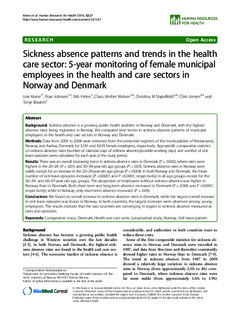| dc.description.abstract | Background: Sickness absence is a growing public health problem in Norway and Denmark, with the highest
absence rates being registered in Norway. We compared time trends in sickness absence patterns of municipal
employees in the health and care sectors in Norway and Denmark.
Methods: Data from 2004 to 2008 were extracted from the personnel registers of the municipalities of Kristiansand,
Norway, and Aarhus, Denmark, for 3,181 and 8,545 female employees, respectively. Age-specific comparative statistics
on sickness absence rates (number of calendar days of sickness absence/possible working days) and number of sick
leave episodes were calculated for each year of the study period.
Results:There was an overall increasing trend in sickness absence rates in Denmark (P = 0.002), where rates were
highest in the 20–29- (P = 0.01) and 50–59-year-old age groups (P = 0.03). Sickness absence rates in Norway were
stable, except for an increase in the 20–29-year-old age group (P = 0.004). In both Norway and Denmark, the mean
number of sick leave episodes increased (P <0.0001 and P <0.0001, respectively) in all age groups except for the
30–39- and 60–67-year-old age groups. The proportion of employees without sickness absence was higher in
Norway than in Denmark. Both short-term and long-term absence increased in Denmark (P = 0.003 and P <0.0001,
respectively), while in Norway, only short-term absence increased (P = 0.09).
Conclusion: We found an overall increase in sickness absence rates in Denmark, while the largest overall increase
in sick leave episodes was found in Norway. In both countries, the largest increases were observed among young
employees. The results indicate that the two countries are converging in regard to sickness absence measured as
rates and episodes.
Keywords: Comparative study, Denmark, Health and care units, Longitudinal study, Norway, Sick leave pattern. | nb_NO |
| dc.description.localcode | © 2014 Krane et al.; licensee BioMed Central Ltd. This is an Open Access article distributed under the terms of the Creative Commons Attribution License (http://creativecommons.org/licenses/by/2.0), which permits unrestricted use, distribution, and reproduction in any medium, provided the original work is properly credited. The Creative Commons Public Domain Dedication waiver (http://creativecommons.org/publicdomain/zero/1.0/) applies to the data made available in this article, unless otherwise stated. | nb_NO |
